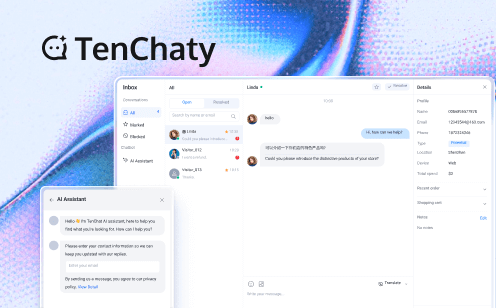10 Expert Tips to Optimize Your Prompt Engineering for Better AI Conversations

In the rapidly evolving world of artificial intelligence, getting the most out of your AI interactions often hinges on how well you craft your prompts. Whether you're using a virtual assistant like Siri or an advanced AI platform such as ChatGPT, or LLM, the quality of your questions directly impacts the responses you receive. This guide will walk you through proven strategies to optimize your prompt engineering, ensuring that your AI understands your intent and delivers more accurate, relevant answers.
Why Choose Tencent RTC for Conversational AI?
Looking to build a powerful, no-code AI Voice Assistant? Tencent RTC is your ultimate solution! With its unmatched versatility, ease of use, and cutting-edge features, Tencent RTC makes implementing Conversational AI a breeze. Here’s why it stands out:

1. Seamless Integration with Multiple AI Services
Tencent RTC supports integration with a wide range of STT, LLM, and TTS providers, including Azure, Deepgram, OpenAI, DeepSeek, Minimax, Claude, Cartesia, Elevenlabs and more. This flexibility allows you to choose the best services for your specific use case. When the LLM provider chooses OpenAI, any LLM model that provides OpenAI-compatible API endpoints is supported here, including Claude and Google Gemini.
2. No-Code Configuration
Tencent RTC simplifies the setup process with a user-friendly interface, enabling you to Configure Conversational AI in just a few minutes. No extensive coding knowledge is required, making it accessible to everyone.
3. Real-Time Interruption Support
Users can interrupt the AI's response at any time, enhancing the fluidity and naturalness of conversations.
4. Advanced Features
AI Noise Suppression: Ensures clear audio input, even in noisy environments.
Latency Monitoring: Tracks real-time performance to optimize conversation flow, including LLM latency and TTS latency.
Switch Providers on the Fly: Without ending the conversation, you can modify the interruption duration, or switch between different LLM and TTS providers (and voice IDs) to experiment with various configurations.
5. Multi-Platform Integration
If you like, Tencent RTC also supports local development and deployment across Web, iOS, and Android platforms, providing flexibility for diverse applications
Ready to see it in action? Watch this video or follow the tutorial to start building your AI Voice Assistant today!
1. Understand Your Goal
Before formulating any prompt, it's essential to have a clear understanding of what you want to achieve. Are you seeking information, troubleshooting an issue, or trying to make a decision? For instance, if you're asking ChatGPT to help with marketing strategies, be specific about the type of strategy you need—whether it’s for social media, email campaigns, or SEO.
Example:
Poor Prompt: "Give me some ideas."
Optimized Prompt: "Provide me with 5 innovative social media marketing strategies for a tech startup targeting millennials."
2. Be Specific and Detailed
AI thrives on clear instructions. The more detailed your prompt, the better it can generate relevant responses. Avoid vague questions that leave room for ambiguity.
Example:
Poor Prompt: "Tell me about AI."
Optimized Prompt: "Explain how machine learning algorithms are used in predictive analytics within the healthcare industry."
3. Break Down Complex Questions
If you're dealing with a complex topic, break your query into smaller, manageable parts. This helps the AI focus on specific aspects and provide more precise answers.
Example:
Poor Prompt: "How can I improve my business sales?"
Optimized Prompts:
"What are the top five strategies for boosting online sales in an e-commerce store?"
"Can you explain how customer segmentation can help increase sales?"
4. Use Examples and Context
Including examples or context can guide the AI to tailor its response to your needs.
Example:
Poor Prompt: "Write a product description."
Optimized Prompt: "Create a compelling product description for a wireless charger, emphasizing its fast-charging capability and portable design."
5. Keep It Simple and Clear
While it's important to be detailed, overly complicated prompts can confuse the AI. Keep your language straightforward and avoid jargon unless necessary.
Example:
Poor Prompt: "Analyze the impact of quantum computing on data encryption methodologies."
Optimized Prompt: "Explain how quantum computing affects current data encryption techniques in layman's terms."
6. Follow a Structured Format
Organizing your prompt with clear instructions can help the AI generate more structured responses. For instance, you can use numbered lists or bullet points to outline your requirements.
Example:
Poor Prompt: "Tell me about renewable energy sources."
Optimized Prompt: "List and describe five major renewable energy sources, highlighting their environmental benefits."
7. Use Role Assignments
Assigning a role to the AI can make its responses more focused and relevant. This technique is particularly effective when using advanced AI agents like Claude or Bard.
Example:
Poor Prompt: "What’s the difference between AI and ML?"
Optimized Prompt: "Act as an AI expert and explain the key differences between artificial intelligence and machine learning in simple terms."
8. Leverage Feedback for Improvement
AI models like ChatGPT or Bard are iterative, meaning they improve with feedback. If a response isn’t what you expected, refine your prompt or provide clarification.
Example:
Poor Response: After asking, "What’s the best way to learn programming?" and receiving a generic answer.
Refined Prompt: "Recommend effective learning strategies for someone new to programming, focusing on self-study resources."
9. Use Constraints
Specify constraints such as tone, length, or style to guide the AI’s response.
Example:
Poor Prompt: "Write a blog post about digital marketing."
Optimized Prompt: "Generate a 500-word blog post about digital marketing trends in 2023, using a professional tone and including statistics."
10. Iterate and Experiment
Prompt engineering is an art that requires practice. Don’t hesitate to experiment with different phrasings or structures to see what works best for your specific use case.
Example:
Experiment: After receiving a response you partially like, modify your prompt to focus on a specific aspect.
Original Prompt: "How can I reduce stress in the workplace?"
Revised Prompt: "Provide actionable tips for reducing work-related stress, focusing on time management techniques."
Conclusion
Mastering prompt engineering is a game-changer when it comes to maximizing the potential of AI tools like ChatGPT, DeepSeek, or Bard. By being specific, structured, and clear in your queries, you can unlock more accurate and meaningful responses. Remember, the key to effective prompt engineering lies in understanding your goal, providing context, and continuously refining your approach based on feedback. With practice, you’ll find yourself getting more out of your AI interactions than ever before.

